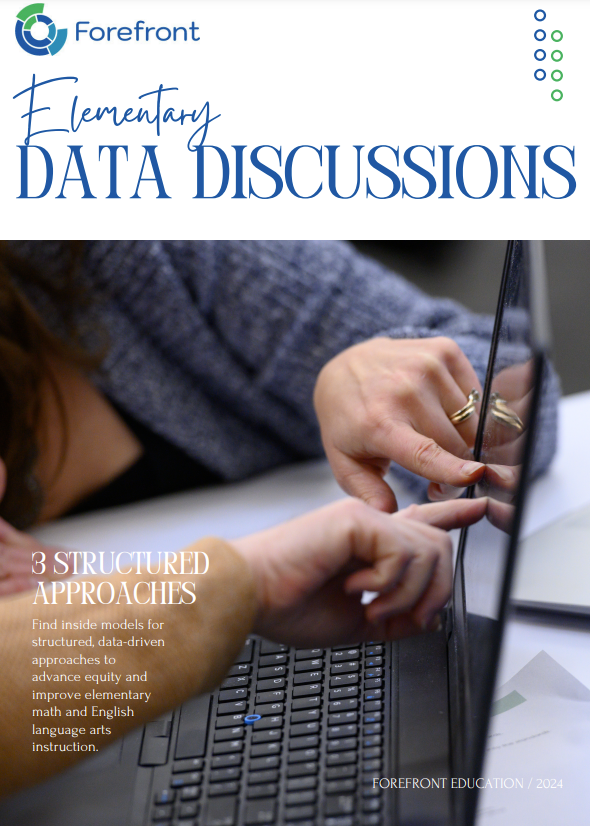3 Steps for Curriculum Implementation
- April 4, 2024
- Blog
Will 2024-25 be the first year of a new curriculum implementation for your school or district? New state policies, evidence-based curricula offerings, and a complete return from pandemic-era survival mode to long-term, strategic planning mean that many districts will be implementing new instructional programs in 2024-25.
There is a lot of complexity to manage with a new curriculum implementation. The level of coordination and communication needed to support a successful implementation is immense. As you plan for a new curriculum implementation, consider these three steps to focus your efforts and ensure success.
Build in time and resources for teachers and leaders to learn
Change is hard. Effective change management provides practitioners with the information they need to successfully use a new curriculum. This may include professional development provided by your internal experts, the publisher, or a third party that provides external expertise and training on the new curriculum.
Even if professional learning is part of your curriculum adoption, prepare and equip your local team to lead: Build in time for instructional leaders to gain deep knowledge of the new resource. This can include attending conferences, connecting with peer districts that have implemented the curriculum, and/or joining affiliate groups. Instructional leaders also need opportunities to model and observe lessons. Expertise in the instructional practices of an instructional program can only be built through practice. Once experts have been identified and developed, leverage their expertise in district and site-level trainings, and coaching. Bringing practical, real-world experience is important for teachers implementing new materials.
Devote time to teacher learning
Teacher learning time is just as valuable as developing leadership expertise with the new resources. Dedicate professional development and collaborative work time for teachers to study, discuss, and plan with the new materials. This can include grade level and department meetings, PLC times, and school and district-level professional learning opportunities. Teachers need opportunities to reflect, discuss, and plan for upcoming units of instruction in the new curriculum. Be sure to encourage teachers to discuss and plan for pacing of individual lessons and units. Pacing is always a challenge with new instructional materials. Addtionally, lesson modeling, peer class observations, and, if your district has instructional coaches, co-teaching lessons are excellent strategies for teachers to gain hands-on experience with the new curriculum.
A curriculum implementation lasts as long as the materials are used. While the initial launch is important, the roll-out period will last 2-3 years before teachers become grade-level experts. Plan for how learning to improve usage of the program will become part of your culture. Look for early successes. The first months of the implementation are critical time for learning about the methods, pacing, and lesson design of the new instructional resource. Helping teachers see and celebrate successes as they are learning the new curriculum will develop local champions. In years two and beyon, continue to look for successes as your continuous improvement efforts gain traction and blossom.
Balance fidelity with teacher autonomy
Fidelity is the big “F” word of curriculum implementation. Teacher expertise and experience need to be balanced with a commitment to using the new curriculum. Experienced teachers who liked the old curriculum may hesitate to embrace the new materials. New teachers, already overwhelmed by learning everything all at once may prefer to “follow the script,” without thinking about differentiation, supports, extensions, and the strategies that expert teachers bring to lessons. It is hard to get the right balance.
What is fidelity? Every teacher brings their own humanness to the classroom. Teachers bring the expression, emotion, thoughtful questioning, varied models, and human intelligence to classroom instruction. No two teachers will deliver a curriculum identically.
Teachers should bring their expertise to the table and use their creativity while they use the materials and topics of instruction. Fidelity comes in the pacing, the use of the materials, and a select set of critical ideas. As an implementation team, identify the most important elements of the program and focus on getting buy in around those elements. These may be the: lesson structure, modeling methods, terminology, routines, visual models or graphic organizers, or assessments. Lesson scripts are helpful, but in the hands of a great performer, they become excellent. High quality fidelity is an artful, thoughtful implementation of the materials and program.
Anticipate teacher roadblocks
There are two challenges that may hold teachers back from using the new program: the growing pains of learning a new program and the fear that their students will be negatively impacted by the proposed changes. Building time and providing resources for teachers to learn, as discussed above, is a key piece of building educator capacity, but the concern that student learning will suffer can also be a reason for educator pushback against a new curriculum.
Teachers sometimes fear that their students will be negatively impacted by the change or the new program itself. This is not unreasonable. When curricula expect prior years’ of learning in that framework, teachers and students may initially struggle to work on pace. Be open, listen, and provide opportunities for vertical work as teachers evaluate how to address needed skills without getting behind. However, be mindful of when this pushback comes from negative beliefs about students. A sense that more rigorous learning is “too challenging” for certain students must be addressed. Here, data can be a helpful tool. Showing how the previous curricula fell short in other measures of student learning, such as state tests, can clarify the need for stronger instruction. Having data to show growth from assessment to assessment or unit to unit (see the next step about data) can help show teachers the possibilities of the new curriculum.
Teaching is a creative, human-centered profession. Fidelity is important, but there still needs to be space for teachers to practice the art of teaching without having every minute of their interaction with students scripted. Allowing teachers to implement a new tool with reasonable flexibility and to apply their professional expertise to adapt instruction to the needs of their students, leads to better job satisfaction and happier staff. Keep the focus on the big picture of the new curriculum adoption — get everyone on the same page on a handful of critical elements — rather than the minute details.
Create a plan for collecting and reflecting on the assessments
Too often, we see districts neglect to provide teachers with guidance related to the assessments of their adopted materials. They do not address the following questions:
- Which assessments should be used?
- How should the assessments be used for grading?
- How should teachers collect and assessment results?
Teachers need to collect assessment results and use them to grade students. This is an essential part of their responsibilities as classroom teachers. Some leaders think that providing no guidance allows teachers to be flexible, but instead, it puts the responsibility on classroom teachers to create their own systems for data collection and grading. As part of your curriculum implementation, provide the tools and guidance on how to collect and organize results from the assessments of your newly adopted materials.
The assessments of instructional programs are important for grading and family communication, but for instructional leaders, these assessments are also valuable tools for your implementation. The assessments included in instructional programs align directly with lessons, and therefore provide the most valid measures of the success of the implementation.
Establish pacing expectations and build in time to look at data
A helpful first step is to have instructional teams plan for and agree upon assessment dates for the summative assessments of each instructional unit. As important as when to administer assessments, is establishing expectations as to when teams will review these results. Ideally, teachers will be provided with time to review assessment results from the new curriculum at regular intervals. Prioritize these assessment results in data meetings. This helps teachers see how students are responding to the new curriculum and plan instructional responses. Looking forward, collecting this data in year one will show instructional trends and successes over time and validate teachers’ efforts during the implementation.
When establishing expectations for data collection, keep in mind that they should be meaningful and manageable for teachers. Meaningful in that they are helpful for teachers, and manageable in that data collection does not become overly burdensome. Teachers cannot collect assessment results from every single assessment opportunity: summative assessments are a good starting place.
As your implementation progresses, these curriculum-embedded assessment results become valuable indicators of success. They become the leading indicators of the return on your curriculum investment. For curriculum leaders, results from the assessments of adopted materials hold timely, detailed information to help lead the implementation. For superintendents and administration, these results help them monitor their strategic plan and student success.
Conclusion
Your district makes critical decisions about its values when adopting a new curriculum. It is an incredible opportunity to spark growth and renew focus. Provide time and resources so that practitioners can gain an in-depth knowledge of these new instructional resources. Be patient with the learning curve. Change takes time.
During this transition, balance your commitment to implementation with fidelity to the new curriculum, with your trust of teachers to apply their expertise and knowledge of their students. This will allow teachers to see positive changes in their classrooms, but not create a culture that demands scripted interactions with students and micromanages details of day-to-day lessons. The big picture here is important. Choose a small number of critical elements of the new curricuum to get people moving in the same direction. Experienced teachers need some freedom to practice their craft within the new curricular framework.
Lastly, when implementing a new program, include a plan to gather and review assessment results from the new curriculum-based assessments. Teachers need ways to collect this information to do their jobs well, and they will appreciate the guidance and support. Setting up expectations for data collection and building in time for teachers to review these new data points, communicates to all stakeholders that you value the new instructional resources and what they will tell you about what students know and don’t know. For leaders, these provide real-time information for monitoring the success of your implementation. They also foster a culture of accountability that is supportive and informs classroom instruction.
About Our Work
Forefront, an assessment data solution, makes assessment results easy-to-collect and visualize. Our reports and data visualizations make assessment data and the insights they can generate accessible from the classroom level to the central office. Explore a 3-minute overview or connect with our school partnerships team today to learn more.
About us and this blog
Our team and tools help schools implement standards-based grading, streamline assessment systems, and use meaningful data to drive decision-making.
Elementary Data Discussions
Access our guide for three models of structured, data-driven approaches to advance equity and improve elementary math and English language arts instruction. Each model shares examples of district and school leadership using assessments at the heart of classroom practice to help drive student outcomes. Access the download page to request your free copy today!

More from our blog
See all postsForefront is the only assessment data solution optimized for classroom assessment results, leveraging these results to fuel instruction, PLCs, and grading. Elevate meaningful assessment data district-wide to transform how you understand and communicate about student learning across your schools.
Copyright © 2025 Forefront Education, Inc. All Rights Reserved.








